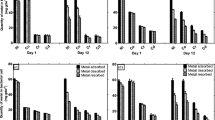Abstract
A marine bacterial strain putatively identified asBacillus thuringiensis strain DM55, showed multiple heavy metal resistance and biosorption phenotypes. Electron microscopic studies revealed that DM55 cells are encased in anionic cell wall polymers that can immobilize discrete aggregates of cations. Factors affecting cell surface affinity for metal cations, monitored by means of Cd2+ binding capability, are investigated. The mechanisms of cadmium resistance and Cd2+ biosorption by the bacterium appeared to be inducible and coincident. Medium components affecting metal removal under cadmium-stressed growth conditions were explored based on the application of two sequential multi-factorial statistical designs. Concentrations of potassium phosphates and peptone were the most significant variables. Optimized culture conditions allowed DM55 cells grown in the presence of 0.25 mM CdCl2 to remove about 79% of the metal ions within 24 h with a specific biosorption capacity of 21.57 mg g−1 of biomass. Both fresh and dry cells of DM55 prepared under cadmium-free optimal nutrient condition were also able to biosorb Cd2+. In addition to the concentration of phosphate in the medium, KinA, a major phosphate provider in the phosphorelay of Bacillus cells, was also demonstrated to regulate the magnitude of cell surface affinity for cadmium ions.
Similar content being viewed by others
References
Amer RM. 1996 Studies on heavy metal resistance of Bacillus species. M.Sc. Thesis submitted to Faculty of Science, Univer-sity of Alexandria, Egypt.
Archibald FS and Duong MN. 1984 Manganese acquisition by Lactobacillus plantarum. J Bacteriol 158: 1–8.
Beveridge TJ and Murray RGE. 1976 Uptake and retention by cell walls of Bacillus subtilis. J Bacteriol 127: 1502–1518.
Bewers JM, Barry PJ, MacGregor DJ. 1987 Distribution and cycling of cadmium in the environment. In: Nriagu JO, Sprague JB eds, Cadmium in the aquatic environment. New York: John Wiely and Sons, Inc, 1–18.
Bonthrone KM, Quarmby J, Hewitt CJ, Allan VJM, Paterson-Beedle M, Kennedy JF, Macaskie LE. 2000 The effect of the growth medium on the composition and metal binding behaviour of the extracellular polymeric material of a metal-accumulating Citrobacter sp. Environ Technol 21: 123–134.
Burke BE, Pfister RM. 1986 Cadmium transport by a Cd 2+ sensitive and a Cd 2+ resistant strain of Bacillus subtilis. Can J Microbiol 32: 539–542.
Chatfield C. 1975 Statistics for Technology. London: Chapman and Mall.
Collins YE, Stotzky G. 1996 Changes in the surface charge of bacteria caused by heavy metals do not affect survival. Can J Microbiol 42: 621–627.
Doyle RJ 1989. How cell walls of Gram-positive bacteria interact with metal ions. In: Beveridge TJ, Doyle RJ, eds, Metal Ions and Bacteria. New York: John Wiely and Sons, Inc., 275–994.
Ehrlich HL 1997. Microbes and metals. Appl Microbiol Biotechnol 48: 687–692.
Fujimaki H, Ishido M, Nohara K. 2000 Induction of apoptosis in mouse thymocytes by cadmium. Toxicol Lett (Shannon) 115: 99–105.
Gruzina TG, Balakina MN, Karamushka VI, Stepura LG, Ul'berg ZR. 1997 Bacterial cell membrane ATPase in assessing heavy metal toxicity. Mikrobiologia 66: 14–18.
Hoch JA. 1993 Regulation of the phosphorelay and the initiation of sporulation in Bacillus subtilis. Ann Rev Microbiol 47: 441–465.
Hulett FM. 1996 The signal-transduction network for Pho regulation in Bacillus subtilis. Mol Microbiol 19: 933–939.
Lang WK, Glassey K, Archibald AR. 1982 Influence of phosphate supply on teichoic acid and teichuronic acid content of Bacillus subtilis cell walls. J Bacteriol 151: 367–375.
Leighton TJ, Doi RH. 1971 The stability of messenger ribonucleic acid during sporulation in Bacillus subtilis. J Biol Chem 246: 3189–3195.
Malvar T, Gawron-Burke C, Baum JA. 1994 Overexpression of Bacillus thuringiensis HknA, a histidine protein kinase ho-mology, bypasses early Spo-mutations that result in CryIIIA overproduction. J Bacteriol 176: 4742–4749.
McLean RJC, Beveridge TJ. 1990 Metal binding capacity of bacte-rial surfaces and their ability to form mineralized aggregates. In: Ehrlich HL, Brierly CL eds, Microbial Mineral Recovery. New York: Mc Graw-Hill Publishing Co, 185–222.
Mera MU, Kemper M, Doyle RJ, Beveridge TJ. 1992 The mem-brane induced proton motive force influences the metal binding ability of Bacillus subtilis cell walls. Appl Environ Microbiol 58: 3837–3844.
Nriagu JO, Lawson G, Wong HKT, Cheam V. 1996 Dissolved trace metals in lakes Superior, Erie, and Ontario. Environ Sci Technol 30: 178–187.
Olson BH, Barkay T, Colwell R. 1979 Role of plasmids in mercury transformation by bacteria isolated from aquatic environments. Appl Environ Microbiol 38: 478–487.
Papachristou E. 1984 The bacterial cell wall and its significance. Acta Microbiologica Hellenica 29: 140–146
Plackett RL, Burman JP. 1946 The design of optimum multifactorial experiments. Biometrika 33: 305–325.
Qi Y, Hulett FM. 1998 Role of Pho–P in transcriptional regulation of genes involved in cell wall anionic polymer biosynthesis in Bacillus subtilis. J Bacteriol 180: 4007–4010.
Sabry SA, Ghozlan HA, Abou-Zeid DM. 1997 Metal tolerance and antibiotic resistance patterns of a bacterial population isolated from sea water. J Appl Microbiol 82: 245–252.
Silver S, Phung LT. 1996 Bacterial heavy metal resistance: new surprises. Ann Rev Microbiol 50: 753–789.
Tynecka ZZ, Gos, Zajac J. 1981 Energy-dependent efflux of cad-mium coded by a plasmid resistance determinant in Staphylo-coccus aureus. J Bacteriol 147: 313–319.
Venkateswarlu V, Reddy P, Manikya, Kumar B, Raj. 1994 Heavy metal pollution in the rivers of Andhra Pradesh, India. J Environ Biol 15: 275–282.
Author information
Authors and Affiliations
Rights and permissions
About this article
Cite this article
El-Helow, E., Sabry, S. & Amer, R. Cadmium biosorption by a cadmium resistant strain of Bacillus thuringiensis: regulation and optimization of cell surface affinity for metal cations. Biometals 13, 273–280 (2000). https://doi.org/10.1023/A:1009291931258
Issue Date:
DOI: https://doi.org/10.1023/A:1009291931258




